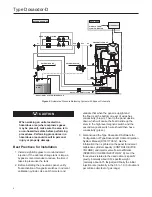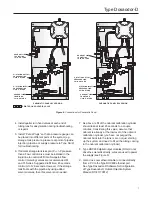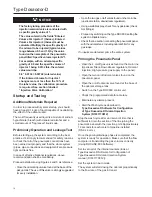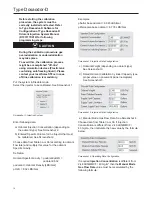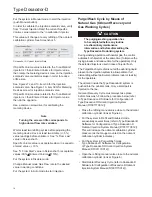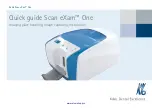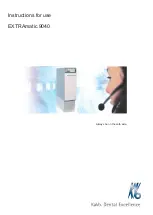
flow rate can also be configured manually to a fixed
value. Odorant injection rate is then calculated using
accumulated flow in order to reduce variability.
In cases where the station does not have a flow
computer, the Type ROC809 can be connected
directly to a pulse output from the turbine or an
analog output from a differential pressure transmitter
(Rosemount Types 3051 and 3095, etc.).
Variability between the calculated and actual injection
volume is used to automatically adjust injection
parameters for any changes in the system and
to detect alarm conditions or system failure, the
odorant calibration cylinder is used to monitor the
actual use of odorant. In the event of power failure,
configuration information and archived historical data
are maintained.
Type Dosaodor-D is designed to purge the odorant
back into the tank in the event that mechanical
maintenance is required. Odorant is pushed back
into the tank and gas is purged through the system to
absorb any remaining liquid.
General Safety Rules
Only qualified personnel shall install and operate the
odorizing system.
Odorizing systems should be installed, operated
and maintained in accordance with international and
applicable codes and regulations.
Installation, operation and maintenance procedures
performed by unqualified personnel may result in
unsafe operation.
This condition may result in equipment damage or
personal, environment injury. If a leak develops in
the system, the escaping gas may accumulate and
become a fire or explosion hazard. Immediately call
qualified service personnel in case of trouble.
The service engineers (operators and maintenance
workers of odorizing systems) shall comply, in any
case, with the following rules:
1. Always wear safety clothing to prevent the product
from coming in contact with the skin, eyes or to
prevent it from being inhaled;
2. In case of leaks or liquid spillage, be prepared to
neutralize or contain the liquid.
Site Requirements
Careful consideration when locating the ROC809 on
the site can help reduce future operational problems.
Consider the following items when choosing a location:
•
Local, state and federal codes often place
restrictions on locations and dictate site
requirements.
Examples of these restrictions are:
the amount of distance from a meter run, distance
from pipe flanges and hazardous area classifications.
Ensure that all code requirements are met.
• Choose a location for the ROC
that minimizes the
length of signal and power wiring.
•
The ROC809 is equipped for radio communications
should be located so the antenna has an
unobstructed signal path.
Antennas should not
be aimed into storage tanks, buildings or other tall
structures. If possible, antennas should be located
at the highest point on the site. Overhead clearance
should be sufficient to allow the antenna to be raised to
a height of at least 20 ft / 6 m.
• To minimize interference with radio communications,
choose a location for the ROC away from
electrical noise sources,
such as engines, large
electric motors and utility line transformers.
• Choose a location for the ROC
away from heavy
traffic areas to reduce the risk of being damaged
by vehicles.
However, provide adequate vehicle
access to aid monitoring and maintenance.
•
The site must comply with class limits of Part 15
of the FCC rules.
Operation is subject to the following
two conditions: (1) The device may not cause harmful
interference and (2) the device must accept any
interference received, including interference that may
cause undesired operation.
Compliance with Hazardous Area Standards
The ROC hazardous location approval is for Class I,
Division 2, Groups A, B, C and D. The Class, Division and
Group terms include:
1.
Class
defines the general nature of the hazardous
material in the surrounding atmosphere. Class I is for
locations where flammable gases or vapors may be
present in the air in quantities sufficient to produce
explosive or ignitable mixtures.
4
Type Dosaodor-D






